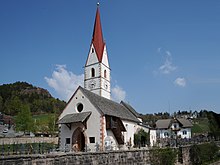Verano
| Verano | |
|---|---|
| (Italian: Verano ) | |
| coat of arms | map |
| State : | Italy |
| Region : | Trentino-South Tyrol |
| Province : | Bolzano - South Tyrol |
| District community : | Burgrave Office |
|
Inhabitants : (VZ 2011 / 31.12.2019) |
931/973 |
|
Language groups : (according to 2011 census ) |
97.90% German 2.10% Italian 0.00% Ladin |
| Coordinates | 46 ° 36 ' N , 11 ° 14' E |
| Altitude : | 595– 2025 m slm (center: 1200 m slm ) |
| Surface: | 22.1 km² |
| Permanent settlement area: | 6.0 km² |
| Parliamentary groups : | Aschl, Veran |
| Neighboring municipalities: | Burgstall , Avelengo , Merano , Mölten , Sarntal |
| Postal code : | 39010 |
| Area code : | 0473 |
| ISTAT number: | 021112 |
| Tax number: | 00253800213 |
| Mayor (2015): | Thomas Egger ( SVP ) |
Vöran ([ ˈføˑran ]; Italian Verano ) is an Italian municipality with 973 inhabitants (as of December 31, 2019) in South Tyrol on the Tschögglberg with a view of the Adige Valley near Merano .
geography
The municipality of Verano extends over the Tschögglberg , a mountain range of the Sarntal Alps that accompanies the Adige Valley between Merano and Bozen on the east side . The village center is located in the lower, middle mountainous areas of the area characterized by forest and meadows in the west of the municipality at an altitude of 1200 m . In addition, there are numerous scattered farms, which on the slopes above the Aschler Bach the hamlet Aschl be attributed.
In the north and south, Verano borders on the Tschögglberg neighboring communities Avelengo and Mölten . In the west, the terrain drops over steep slopes into the Adige Valley at the height of Burgstall . In the northeast, the municipality finds its highest point on the watershed to the Sarntal , over which the border to the Sarntal municipality of the same name runs, at around 2000 m .

history
Verano was first mentioned in 1186 in a certificate of ownership by Pope Urban III. for the Augustinian canons of Au-Gries (today Muri-Gries ) in Bozen as "Veran" . As a whole, the Tschögglberg even Verano was in the 13th century as an excellent arable and cereal construction area declared and as such is in the princely arable called, so in that of Meinhard II. Of 1285/90. The municipality belonged to the judicial district of Merano until the end of the First World War and was part of the district of Merano .
economy
Vöran was one of 10 model communities of the Arbeitsgemeinschaft der Alpenländer (Arge Alp) and therefore has a biosolar heating plant, which supplies the village center with heat using renewable fuels .
From an economic point of view, the modern, up-and-coming agriculture - the more than 70 farms are now mostly fully mechanized - the equally flourishing handicrafts and tourism should be emphasized. Many people from Verano also commute to the cities of Meran and Bozen or to the surrounding villages (Avelengo, Mölten, Burgstall and Sarnthein ).
Verano is one of the sunniest villages in South Tyrol. Due to the altitude, the southwest orientation and the favorable location on a high plateau, Verano can look forward to a long evening sun (Merano, for example, has long been in the shade). Verano also receives the morning sun early.
politics
Mayor since 1952:
- Ignaz Kröss: 1952–1976
- Johann Kienzl: 1976–1985
- Alfons Alber: 1985-2010
- Thomas Egger: since 2010
traffic
The community is accessible for car traffic via the state road 98, which connects the Tschögglberg communities of Avelengo , Verano and Mölten from Merano and Terlan .

Since 1957, the mountain village has also been accessible by the Vöran cable car from Burgstall in the Adige Valley . In 2017 the original construction was replaced by a completely new system.
Worth seeing
- the Knottnkino , a specially designed lookout point on the porphyry rock Rotsteinkogel
Population development

Web links
- Homepage of the municipality of Verano
- Landscape plan of the municipality of Verano . Office for Landscape Ecology, Autonomous Province of Bolzano - South Tyrol (PDF file)
- Entry in the Tirol Atlas of the Institute for Geography at the University of Innsbruck
Individual evidence
- ^ Franz Huter : Tyrolean document book . I. Abt. Volume 1. Innsbruck: Wagner 1937. S. 226, No. 429.
- ↑ Hannes Obermair , Volker Stamm : Alpine economy in high and low altitudes - the example of Tyrol in the late Middle Ages and early modern times . In: Luigi Lorenzetti, Yann Decorzant, Anne-Lise Head-König (eds.): Relire l'altitude: la terre et ses usages. Suisse et espaces avoisinants, XIIe – XXIe siècles . Éditions Alphil-Presses universitaires suisses, Neuchâtel 2019, ISBN 978-2-88930-206-2 , p. 29-56, reference p. 34 ( researchgate.net ).
- ↑ The mayors of the South Tyrolean municipalities since 1952. (PDF; 15 MB) In: Festschrift 50 Years of the South Tyrolean Association of Municipalities 1954–2004. Association of South Tyrolean municipalities, pp. 139–159 , accessed on November 16, 2015 .






